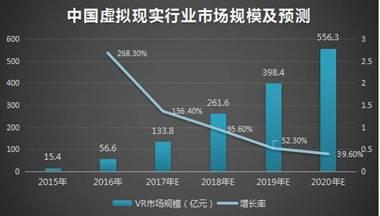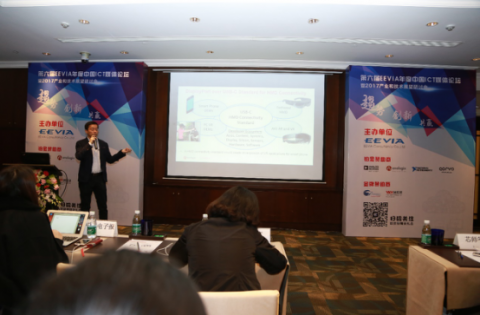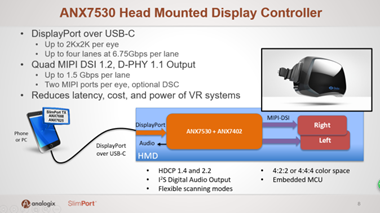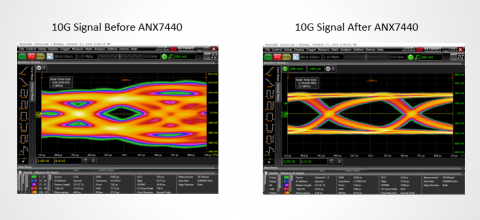“With 4K Resolution + 120Hz refresh rate, ANX7530 is expected to break through obstacles and break the VR industry dilemma”
With multi-line penetration in the field of gaming, live entertainment, education, health care, retail, etc. VR is expected to become the hottest innovation and technology industry, with the global market’s industry giants entering the industry and an outbreak is just around the corner.
If the Virtual Reality (VR) industry in 2015 was just in the germinating stage, less than two years later, it has seen a great expansion with very considerable development prospects. According to the latest Institute of Speedway, data shows that in 2016 the Chinese VR industry market size was 5.66 billion yuan, compared with the previous year growth rate of up to 268.3%, and showed a year-over-year growth trend is expected in 2020, Virtual reality industry market size will reach 55.63 billion yuan, 2016 doubled, the market potential is evident.

figure 1. Speedway Institute announced the Chinese virtual reality (VR) industry market size and forecast data
However, "the reality is very skinny", due to low resolutions, low refresh rates causing vertigo, hence many VR products for mobile phones, PC and software compatibility have not reached technology maturity and the user experience is not good enough, which has been a major obstacle to the outbreak of the VR industry.
On January 17, 2017, at the 6th EEVIA China ICT Media Forum and 2017 Industrial and Technology Outlook Seminar, Analogix’s product manager Mr. Hu Weining talked about "DisplayPort over USB-C high-speed interface for VR products” and the new products’ applications "as the theme for his presentation in front of 40 industry specialists, senior media and nearly a hundred industry engineers and developers, explaining the simple USB Type-C use-case in the VR industry, innovative applications and the "the right medicine" to solve technical problems.
With 4K Resolution +120 Hz refresh rate, ANX7530 is expected to break through the obstacles of the outbreak of the VR industry.

figure 2. Analogix Product Manager Mr. Hu Weining Forum speech site
4K Resolution + 120Hz refresh rate, ANX7530 helps USB Type-C become a serious application for VR industry
At the forum, Manager Hu introduced the recent "stunning" CES 2017's SlimPort VR chip ANX7530. As the first DisplayPortTM to Quad MIPI-DSI display controller, the ANX7530 supports a refresh rate of up to 120 frames per second (FPS), primarily for VR and AR heads-up displays (HMDs).

image 3. Analog Devices' Latest "Core" Products - VR / AR Headset Display Controller ANX7530
As shown above, for example, the left side of the smart phone with a full-featured USB Type-C, through the USB cable, that is, through the ANX7530, ANX7530 DP protocol will be converted to the VR screen that can identify the MIPI signal and supports each Eye to receive 8 MIPI channel (a total of 16 channels), and then through the two MIPI interface (left and right sides of the screen), support VR helmet left and right screen driver, ANX7530 can support up to 2K × 2K monocular resolution, 4K resolution, very suitable for common VR screen resolution.
More detailed performance indicators for the ANX7530 are as follows:
· DisplayPort 1.4 input, supports up to 6.75Gbps link frequency;
· HDCP 2.2 and 1.4 high-bandwidth digital content protection support to ensure safe distribution of video content;
• DisplayPort input adaptive equalization for best-in-class signal recovery for interconnect VR HMD applications;
· MIPI-DSI 1.2 output, supports up to 1.5Gbps link frequency, each eye to receive four or eight channels.
With 4K resolution combined with 120Hz refresh rate, the ANX7530 launch could be heard all the way from Las Vegas to the Mainland market for VR equipment manufacturers. It can be said that ANX7530 is currently very hot, and domestic and foreign mobile phone manufacturers and major manufacturers of VR helmets are also very interested in the product of the Silicon Valley company.
Since the ANX7530 does not have the CC (logic detection and control) and PD (Power Delivery) functions, it needs to be combined with the ANX7402 chip with a USB-C port controller and a PD, which means that it is currently a two-chip solution program.
In addition to the ANX7530, Hu also introduced another chip, the ANX7440, which incorporates a 10 Gbps re-timer and a USB-C switch for DisplayPort over USB Type-C ports for signal attenuation when the cable distance is long. As shown below, the left figure is the actual signal without the ANX7440, and the right diagram is the actual eye diagram after the ANX7440. In the future, just add ANX7440 in the wire, you can support longer cable length for VR headsets without failure in the display, which has a more prominent role for the PC VR (with a PC connected to the VR device).

Figure 4. Silicon Valley ANX7440 analog-to-digital eye effect comparison (the left is not ANX7440, the right side of the opposite)
Standardization is the cornerstone of ecological construction, USB Type-C has gradually become the standard VR
At present, VR application equipment mainly presents two main forms, one for the PC VR, that is connected with the PC VR device, such as OculusRift; another for the smart phone VR, that is connected with a smart phone VR device, such as Samsung Gear.
Unlike the PC-VR form, the portability of smart phones connected to VR devices is its significant advantage, and the biggest advantage of this program is basically that the smart phone has become a standard for everyone, the advantages of low-cost close at hand. USB Type-C, a versatile interface that carries video output, power, and data, simplifies all of this, and Analogix Semiconductor also focuses on VR applications that connect mobile phones.
Even with PC VR, the USB Type-C interface can also be "improved". This is different from using two cables to connect HDMI and USB, USB Type-C "first-line wins".
In fact, more than VR, USB Type-C is a big ecologically, its appearance has changed a lot of areas of connection, flat and thin and light notebook is USB Type-C of the earliest applications, with Apple releasing a new generation Macbook in early 2015 with USB Type-C and then the term has become well known. Apple seems to be USB Type-C to the "altar", the past two years, USB Type-C's jump has reached amazing speed.
Smart phones are the most important market and growth drivers for USB Type-C. 16 high-end flagship smartphone brand models, such as Huawei P9 and Glory V8, Samsung Galaxy Note 7, millet 5, music as Max, LG G5, Meizu, HTC 10 are basically equipped with a USB Type-C. At present, the market's flagship model of the new mainstream, has begun to use the USB Type-C interface.
Next, the USB Type-C combines high-speed data, fast charging, audio and video in one, the most suitable for VR/ AR equipment, due to its high-definition, large bandwidth, low latency and human-computer interaction support for VR/AR requirements. USB Type-C will be the ultimate solution for connecting VR/ AR devices to PCs and mobile phones. In the future, USB Type-C will become an important interface choice in digital headphones, flat-panel TVs, automotive and IOT.
Mr. Hu believes that the rapid development of USB Type-C is due to its standardization. Standardization is the cornerstone of USB Type-C. In the future, VR devices and smart phones from different manufacturers will interoperate, which is standardized Superiority. Science and technology are achievements in life in many ways, but convenience has always been one of the core factors. I believe 2017 will become the high-profile year for USB Type-C applications.
